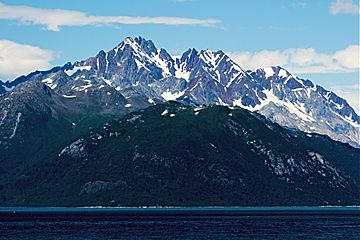Mount Abdallah facts for kids
Quick facts for kids Mount Abdallah |
|
|---|---|

Mount Abdallah
|
|
| Highest point | |
| Elevation | 6,210 ft (1,890 m) |
| Prominence | 2,210 ft (670 m) |
| Parent peak | Mount Barnard (8173 ft) |
| Geography | |
| Location | Glacier Bay National Park and Preserve Hoonah-Angoon Alaska, United States |
| Parent range | Alsek Ranges Saint Elias Mountains |
| Topo map | USGS Mount Fairweather D-3 |
| Climbing | |
| Easiest route | Scrambling Northeast ridge |
Mount Abdallah is a tall mountain in southeast Alaska. It stands 6,210 feet (about 1,893 meters) high. This mountain is part of the Alsek Ranges and the larger Saint Elias Mountains.
You can find Mount Abdallah inside Glacier Bay National Park and Preserve. It is the highest point between two water areas called Tarr Inlet and Rendu Inlet. The mountain is about 93 miles (150 km) northwest of Juneau. It is also about 10.5 miles (17 km) southeast of Mount Barnard, which is an even taller peak nearby.
Even though Mount Abdallah is not the tallest mountain, it rises very steeply. It goes from the ocean's edge to its peak in less than three miles. This makes it look very impressive.
The mountain was named in 1892 by Harry Fielding Reid. He was an American geophysicist. A geophysicist studies the Earth using physics. In 1892, Reid led a team to study glaciology in Glacier Bay. Glaciology is the study of glaciers. We don't know for sure who Reid named the mountain after. It might have been someone from his expedition team.
The best time to see Mount Abdallah is usually from May through June. The weather is often clearer then. If the weather is good, you can see Mount Abdallah from Glacier Bay. Many cruise ships visit Glacier Bay, so it's a popular spot for visitors.
Weather Around Mount Abdallah
Mount Abdallah has a subarctic climate. This means it has very cold, snowy winters. The summers are usually mild. Temperatures can drop below −20 °C (which is −4 °F). With wind, it can feel even colder, sometimes below −30 °C (−22 °F).
This cold climate helps two glaciers survive on the mountain. The Romer Glacier is on the east side. There is also an unnamed glacier on the north side. Water from melting snow and ice from these glaciers flows into Glacier Bay Basin.
Images for kids







